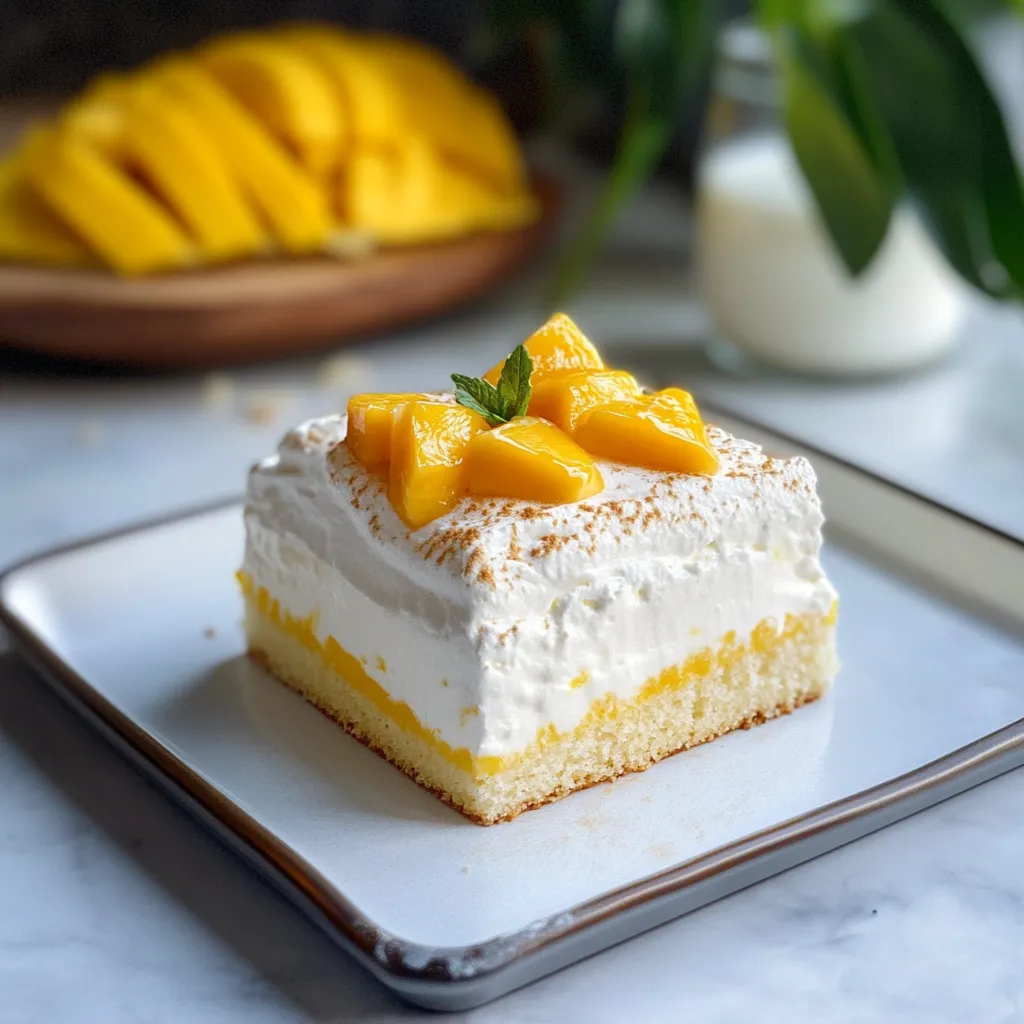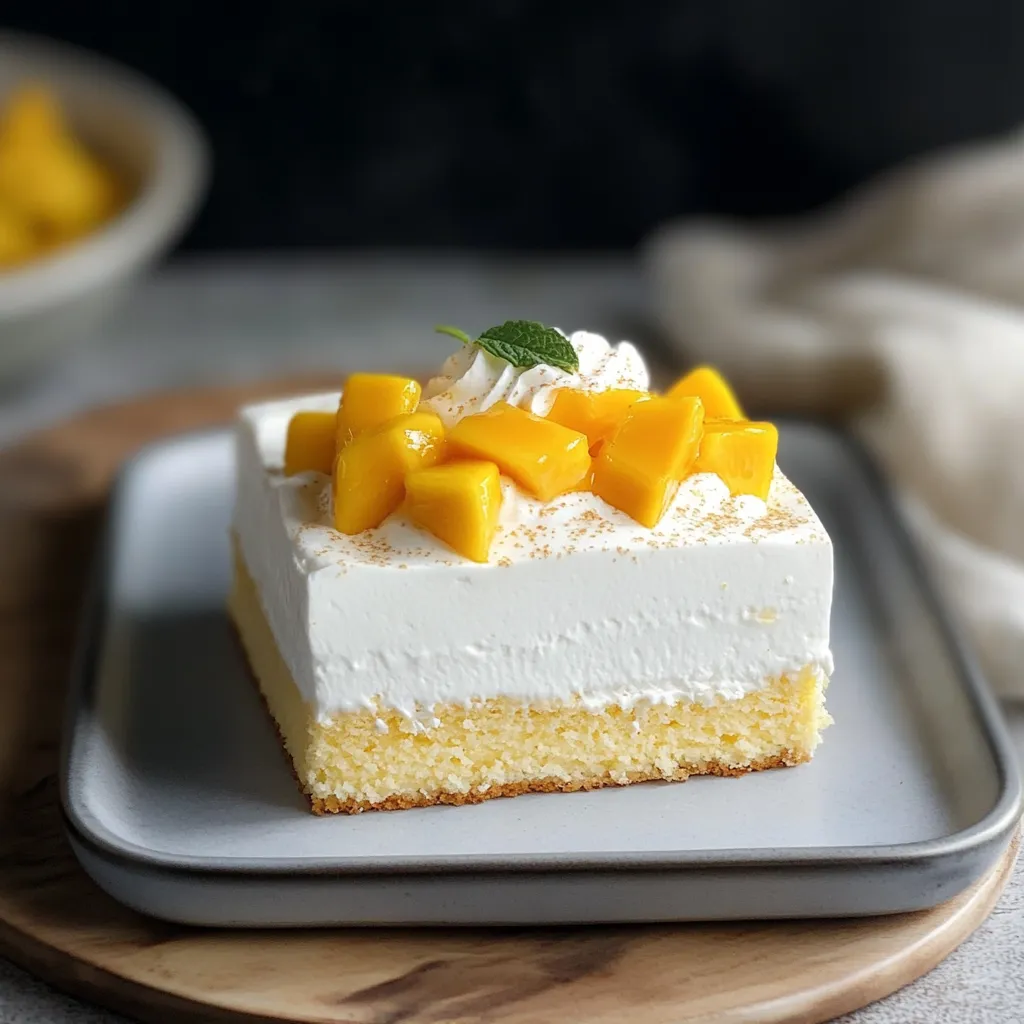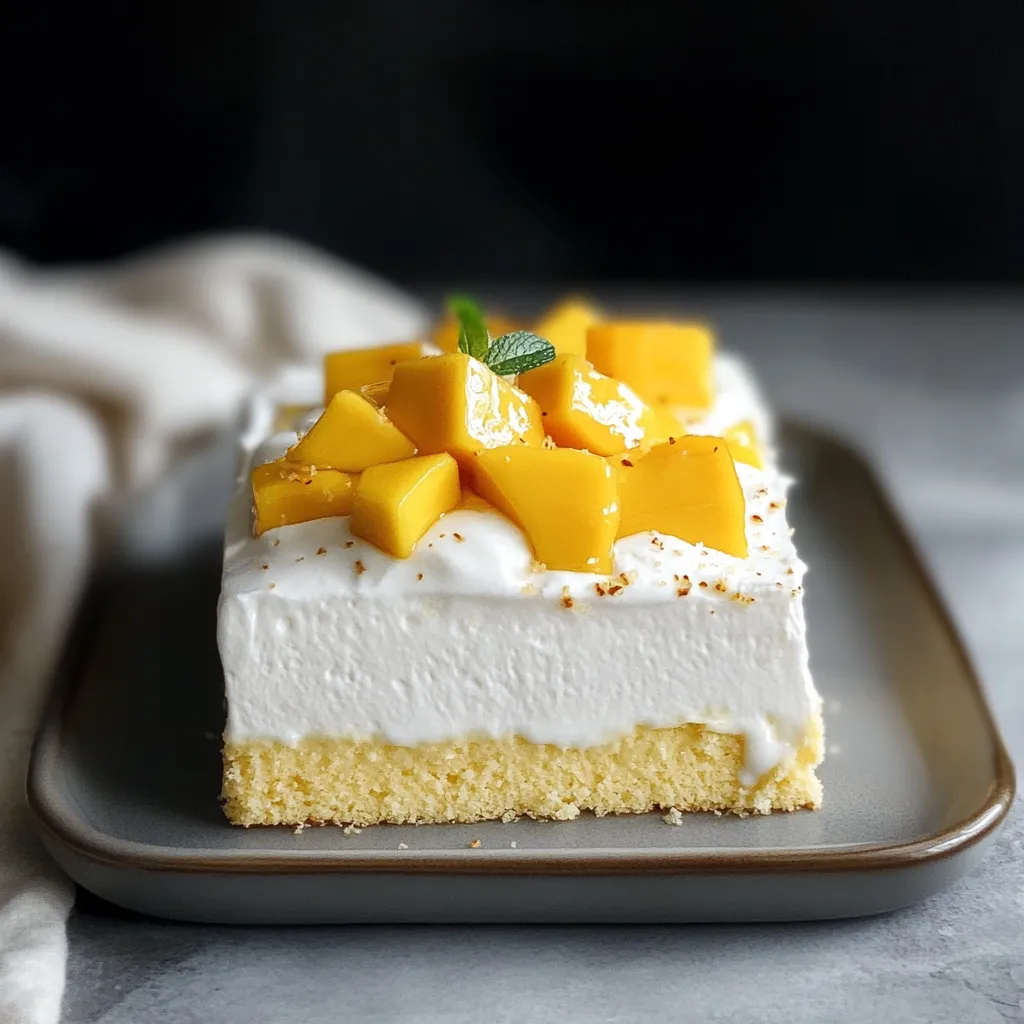 Pin it
Pin it
Sunlight filters through ripe mangoes, transforming ordinary tres leches cake into an extraordinary summer indulgence bursting with tropical flavor. This innovative twist combines the beloved Latin American soaked cake tradition with the refreshing Indian mango lassi drink, creating a cross-cultural dessert masterpiece that celebrates mango season perfectly. Each forkful delivers incredible moisture and vibrant mango essence that permeates every layer from the delicate sponge to the billowy whipped topping.
I stumbled upon this creation during a particularly sweltering summer afternoon while entertaining friends from different cultural backgrounds. The mangoes sitting on my counter were perfectly ripe, calling out to be transformed into something special. When I served this cake, conversations stopped mid-sentence as everyone savored their first bite. My friend's grandmother, who rarely compliments non-traditional desserts, requested the recipe before leaving—my ultimate seal of approval.
Ingredient Treasures
- Alphonso mangoes: Deliver unparalleled sweetness and fragrance, though Ataulfo or Kent varieties make excellent substitutes when perfectly ripened.
- Full-fat Greek yogurt: Provides tangy richness essential for authentic lassi flavor. Avoid low-fat versions which lack proper consistency.
- Cardamom powder: Introduces subtle floral notes that enhance mango's natural perfume without overpowering.
- Superfine sugar: Dissolves completely during mixing, creating ideal texture in both cake and topping.
- Pure vanilla extract: Balances the tropical notes with warm undertones. Use genuine extract rather than artificial flavoring.
- Cornstarch: Lightens the flour mixture, ensuring tender crumb that absorbs milk mixture beautifully.
Baking Instructions
- Preparing perfect sponge
- Separate eggs completely, ensuring no yolk contaminates whites. Whip egg whites with clean beaters until soft peaks form, then gradually incorporate sugar until glossy stiff peaks develop. Meanwhile, beat yolks with remaining sugar until pale yellow and tripled in volume, approximately 5 minutes. Sift dry ingredients together three times for optimal incorporation.
- Creating airy texture
- Fold egg whites into yolk mixture using large rubber spatula with gentle downward stroke followed by circular motion. Incorporate just until no white streaks remain visible, taking care not to deflate air bubbles that create essential structure. Transfer to prepared pan without excessive spreading or smoothing.
- Baking with precision
- Place in center rack of preheated oven, avoiding opening door during first 20 minutes of baking. Test with wooden skewer inserted in center, looking for moist crumbs rather than wet batter. Cool in pan for 10 minutes before inverting onto cooling rack.
- Developing mango infusion
- Peel and cube perfectly ripe mangoes, selecting fruit that yields slightly to gentle pressure. Blend with yogurt and cardamom until silky smooth, passing through fine-mesh sieve to remove any fibrous portions. Reserve portion for topping before combining remainder with traditional milk mixture.
- Soaking technique
- Pierce cooled cake thoroughly with wooden skewer at half-inch intervals. Pour milk mixture in three separate applications, allowing each addition to absorb fully before adding more. Cover and refrigerate overnight for complete flavor development and texture transformation.
- Creating cloud-like topping
- Chill mixing bowl and beaters in freezer for 15 minutes before whipping cream to soft peaks. Gradually incorporate reserved mango mixture while continuing to beat until firm enough to hold shape without becoming grainy. Apply generously to fully soaked cake with offset spatula.
 Pin it
Pin it
My grandmother always emphasized the importance of patience when making soaked cakes. Following her wisdom, I discovered that allowing the mango-infused milk mixture to penetrate slowly, over several applications, creates perfect texture throughout. When I rushed this process once for a last-minute gathering, the cake was good but lacked the exceptional moisture distribution that makes this dessert truly memorable.
Temperature Mastery
Proper temperature control significantly impacts this recipe's success. Eggs separate more easily when cold but whip to greater volume at room temperature, so separate immediately from refrigerator then allow to warm naturally for 30 minutes. Conversely, cream whips most successfully when thoroughly chilled, including the mixing bowl and beaters. The cake itself should be completely cooled before soaking to maintain structural integrity.
Serving Inspirations
Present individual portions with fanned mango slices and a light dusting of ground cardamom for elegant presentation. Small sprigs of fresh mint add beautiful color contrast and refreshing aromatic notes. For special occasions, serve alongside a small glass of additional mango lassi topped with edible flower petals. During afternoon gatherings, pair with masala chai tea whose warming spices complement the cake's cooling properties beautifully.
Creative Adaptations
Experiment with different fruit combinations by incorporating passion fruit pulp into the mango mixture for tropical complexity. Those avoiding dairy can substitute coconut cream for heavy whipping cream and coconut yogurt for traditional yogurt, creating entirely new flavor dimensions. Adding a thin layer of diced fresh mango between the cake and topping introduces textural contrast, while incorporating crushed pistachios around the edges provides elegant green accent and delightful crunch.
Preservation Wisdom
Store leftover cake in refrigerator, covered tightly with plastic wrap directly against exposed surfaces to prevent drying. Individual portions freeze surprisingly well when wrapped individually in plastic followed by aluminum foil, though topping should be added fresh after thawing. For best results when serving previously refrigerated cake, allow to sit at room temperature for 15 minutes to soften slightly and enhance flavor perception.
 Pin it
Pin it
My journey with this recipe taught me that true culinary innovation often happens at cultural intersections. The magical transformation that occurs when Latin American and South Asian culinary traditions meet creates something entirely new yet somehow familiar. This cake represents summer's fleeting sweetness captured in each bite, demonstrating how seasonal inspiration combined with global techniques can elevate familiar desserts into extraordinary experiences worth savoring slowly.
Frequently Asked Questions
- → Can I use canned mango pulp instead of fresh mangoes?
- Yes, canned mango pulp works well in this recipe. Use about 1½ cups of pulp for the mango lassi, but you might need to adjust the sugar since canned pulp is often pre-sweetened. For the decoration, however, fresh mango chunks still work best for texture and appearance.
- → How far in advance can I make this Mango Lassi Tres Leches Cake?
- You can make the cake up to 2 days in advance. In fact, it tastes even better after sitting overnight as the flavors meld together. Just wait to add the whipped cream topping and fresh mango decoration until a few hours before serving for the best appearance.
- → Can I make this cake gluten-free?
- Yes, you can substitute the all-purpose flour with a gluten-free flour blend designed for baking (one that contains xanthan gum). The rest of the ingredients in the Mango Lassi Tres Leches Cake are naturally gluten-free.
- → What can I substitute for cardamom if I don't have any?
- If you don't have cardamom, you can use a small pinch of cinnamon or a drop of vanilla extract, though the flavor profile will be different. Cardamom gives the authentic Indian lassi flavor, but the cake will still be delicious without it.
- → Why does my milk mixture take so long to absorb?
- If your milk mixture is absorbing slowly, it might be too thick or your cake might be too dense. Make sure to thoroughly poke holes in the cake and thin the remaining mixture with a little extra regular milk. Also, be patient - sometimes it just takes time for all that goodness to soak in!
- → Can I freeze leftovers of this cake?
- While you can freeze the soaked cake portion, the texture of the whipped cream topping will suffer in the freezer. If you need to freeze it, do so without the topping and add fresh whipped cream after thawing in the refrigerator overnight.
